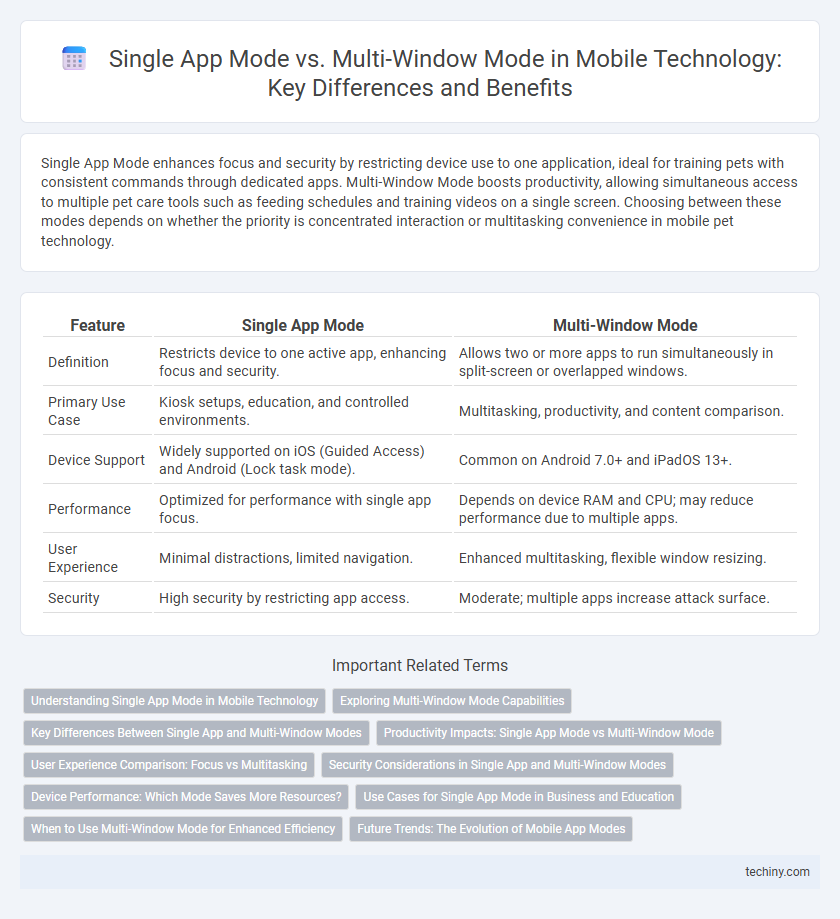Single App Mode enhances focus and security by restricting device use to one application, ideal for training pets with consistent commands through dedicated apps. Multi-Window Mode boosts productivity, allowing simultaneous access to multiple pet care tools such as feeding schedules and training videos on a single screen. Choosing between these modes depends on whether the priority is concentrated interaction or multitasking convenience in mobile pet technology.
Table of Comparison
| Feature | Single App Mode | Multi-Window Mode |
|---|---|---|
| Definition | Restricts device to one active app, enhancing focus and security. | Allows two or more apps to run simultaneously in split-screen or overlapped windows. |
| Primary Use Case | Kiosk setups, education, and controlled environments. | Multitasking, productivity, and content comparison. |
| Device Support | Widely supported on iOS (Guided Access) and Android (Lock task mode). | Common on Android 7.0+ and iPadOS 13+. |
| Performance | Optimized for performance with single app focus. | Depends on device RAM and CPU; may reduce performance due to multiple apps. |
| User Experience | Minimal distractions, limited navigation. | Enhanced multitasking, flexible window resizing. |
| Security | High security by restricting app access. | Moderate; multiple apps increase attack surface. |
Understanding Single App Mode in Mobile Technology
Single App Mode in mobile technology restricts device usage to a single application, enhancing focus and security by preventing access to other apps or system functions. This mode is commonly used in educational settings, retail kiosks, and enterprise environments to limit distractions and maintain controlled user interactions. Configured via mobile device management (MDM) solutions, Single App Mode ensures consistent operation and compliance with organizational policies.
Exploring Multi-Window Mode Capabilities
Multi-Window Mode enhances mobile productivity by allowing users to run and interact with multiple applications simultaneously on a single screen, optimizing multitasking efficiency. This capability supports resizing windows, drag-and-drop functionality, and seamless app switching, tailored for devices with larger displays or foldable screens. Advanced mobile operating systems like Android 12 and iOS 15 offer refined Multi-Window Mode features that improve user experience by enabling parallel workflows and real-time data access across apps.
Key Differences Between Single App and Multi-Window Modes
Single App Mode restricts device usage to a single application, enhancing focus and security, ideal for kiosk or educational environments. Multi-Window Mode allows simultaneous use of multiple applications, boosting multitasking efficiency by enabling users to split the screen and interact with different apps side-by-side. Key differences include user control, with Single App Mode offering limited interaction confined to one app, whereas Multi-Window Mode supports flexible workflows by managing multiple apps concurrently.
Productivity Impacts: Single App Mode vs Multi-Window Mode
Single App Mode enhances focus by limiting distractions, allowing users to dedicate full attention to one task, which boosts deep work and task completion efficiency. Multi-Window Mode supports multitasking by enabling simultaneous use of multiple applications, improving workflow flexibility and real-time information access. Productivity gains in Multi-Window Mode depend on users' ability to manage split attention, while Single App Mode benefits arise from reduced cognitive load and task interruption.
User Experience Comparison: Focus vs Multitasking
Single App Mode enhances user focus by limiting device usage to one application at a time, reducing distractions and improving task completion efficiency. Multi-Window Mode supports multitasking by allowing users to interact with multiple apps simultaneously, increasing productivity but potentially dividing attention and cognitive resources. User experience preference depends on the need for deep focus versus the ability to manage and switch between several tasks seamlessly.
Security Considerations in Single App and Multi-Window Modes
Single App Mode enhances security by restricting device usage to a single application, minimizing risk from unauthorized access and data leakage. Multi-Window Mode increases exposure to security vulnerabilities by enabling multiple apps to run simultaneously, which can lead to potential data crossover and increased attack surfaces. Device administrators often prefer Single App Mode in high-security environments to enforce strict control over user interactions and sensitive information.
Device Performance: Which Mode Saves More Resources?
Single App Mode conserves device resources by limiting background processes and reducing CPU and RAM usage, resulting in smoother performance and longer battery life. Multi-Window Mode consumes more memory and processing power as it runs multiple applications simultaneously, increasing system load and potentially causing slower response times. Devices with limited hardware capabilities benefit more from Single App Mode due to its efficiency in resource allocation.
Use Cases for Single App Mode in Business and Education
Single App Mode enhances focus and security by restricting device usage to a single application, making it ideal for business environments like retail kiosks and healthcare settings where controlled access is critical. In education, this mode supports distraction-free learning on tablets during exams or interactive lessons by locking the device to specific educational apps. Its application boosts productivity and compliance by minimizing unauthorized app switching and data leakage risks.
When to Use Multi-Window Mode for Enhanced Efficiency
Multi-Window Mode enhances efficiency by enabling simultaneous use of multiple applications, ideal for multitasking scenarios like comparing documents or monitoring communication channels. This mode boosts productivity in mobile technology by allowing seamless interaction between apps without constant switching. Implementing Multi-Window Mode is particularly beneficial for professionals who manage complex workflows requiring quick access to diverse data sources.
Future Trends: The Evolution of Mobile App Modes
Single App Mode ensures device security and user focus by restricting access to one app, which remains crucial for enterprise and educational sectors. Multi-Window Mode enhances productivity by enabling simultaneous app usage, gaining traction with foldable and larger screen devices. Future trends indicate integration of AI-driven context awareness to dynamically switch modes, optimizing user experience and device performance.
Single App Mode vs Multi-Window Mode Infographic

 techiny.com
techiny.com